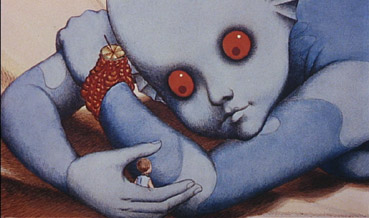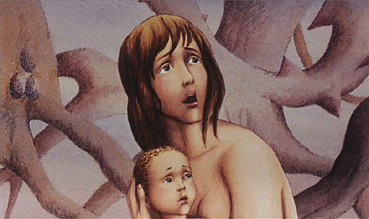|
While
the debate continues over whether live action feature films
can really be classified as art, the case is and always
has been a lot easier to make for animation. The animated
short in particular is often a labour of love for its creator
and free of the commercial pressures that most features are saddled with and that so many filmmakers find themselves battling against.
Such films can and often do exist as expressions of the animator's
artistic vision, and their pleasures relate less to character
and narrative than the design and animation itself. Like
painting or sculpture, an animated short can be admired
and enjoyed for its composition and for its technique and
can provoke an emotional response purely on the basis of
its artistic qualities.
What
works for ten minutes, however, cannot not necessarily be stretched
to feature length, and the animated feature, although still
easy to appreciate for its design and technique, generally requires
a storyline on which the art can be hung. Animated features require
a considerable amount of time, effort and money to produce, and those who fund
them expect to see a return on their investment. Be artistic,
sure, but at least tell a story that will get people into
the cinema to see it. Which in some ways brings us full circle – given these commercial constraints, can an animated feature
really be categorised as art? I am here to assure that it
can. You want proof? It's right here, on this DVD, in pretty
much every frame of René Laloux's extraordinary film.

If
you've never heard of Fantastic Planet
(La Planète sauvage – literally 'The
Savage Planet'), it's hardly surprising. Made in 1973,
it did the rounds of UK art-house cinemas in the years that
followed, sometimes teamed up with a second, more commercial
feature to get the punters through the door. I first saw it back
in 1980 on a double bill with Ridley Scott's Alien,
of all things. Don't get me wrong, I adore Alien,
but this was still a peculiar pairing, and many of those drawn
to Scott's sf/horror masterpiece would be unlikely to sit
still for Laloux's equally distinctive but stylistically
very different vision. Since then, the film has sunk into
virtual obscurity, at least in the UK (it has apparently
found a small but devoted late night audience in the USA),
and news that Masters of Cinema were to revive it for UK
DVD release had me bopping about with glee. That first viewing
had made a serious impression, but a lot of time had passed
since then. Twenty-six years and a LOT of films later, would it
still look so remarkable, so innovative?
Oh
yes.
La
Planète Sauvage is, as the title suggests,
a science fiction story, but one unusually strong on the suggestively
subtextual. On the planet of Ygam, the diminutive, human-like
Oms lead an uncomfortable co-existence with the giant, blue-skinned
Draags. The Draags regard the Oms largely as vermin, but
some of the Draag children keep them as playthings, holding
them captive with collars that can be used to physically recall their wearers by remote
control. The focus of the story is Terr, a baby Om
whose mother is killed and who is rescued and domesticated
by a young Draag named Tiwa. As Tiwa grows, her schooling
is undertaken through a telepathic headset through which
she absorbs knowledge, but unbeknown to her, Terr is able
simultaneously receive the information. Eventually, Terr
escapes, taking the headset with him, and joins a colony
of Oms who live in an big tree in a park. Armed with the
headset, they set about improving their own knowledge, while
the Draags continue their periodic process of Om extermination.
Although
you'll find the dual species/master-slave/oppressor-rebellion
story throughout science fiction literature and even film
(Planet of the Apes anyone?), it remains
a potent one because of its metaphoric meat in a world that
seems incapable of learning from history. But if the story seems
familiar then the handling is anything but. Working with graphic artist Roland Topor, composer
Alain Goraguer and sound effects deviser Jean Guérin,
Laloux creates an alien world like nothing you'll have seen
or heard, a consistently extraordinary multimedia artwork
in which sound, art design and movement are exquisitely
combined into a vividly surrealistic whole. The occasionally
recognisable touchstones are there – Bebe and Louis Barron's
electric tonalities for Forbidden Planet,
the playful cut-out surrealism of early Terry Gilliam animations – but the vision here is so complete that they feel more coincidental
than in any way borrowed or adapted.

Although
principally compelling for its technique – every few seconds
there is something to widen the eyes or drop the jaw – the
story still makes for fascinating reading and interpretation.
The death of Terr's mother, for example, is the result not
of calculated nastiness but the thoughtless game-playing
of the Draag children, offering a reading that questions our attitude
to all forms of wildlife, domesticated or otherwise. This is carried through in the treatment of Terr as
Tiwa's pet, dressed in a variety of absurd costumes for
its owner's amusement and held captive with a collar that
can return him to his owner at the flick of a lever.
The descriptions of Oms as vermin, the complaints about
the speed at which they reproduce and the later extermination programme can't help but recall Australia's problems
with wild rabbits and their attempts to control and ultimately
wipe them out in the 1950s. But in making both species humanoid
in form, Laloux inevitably invites an interpretation that
has the Draags as an army of occupation and the oppressed
Oms as their victims. Abused, domesticated and ultimately
gassed in coldly systematic attempt at genocide, the picture
is completed when the Oms learn to organise and fight back
against their oppressors. It has been suggested that the
film was a response to the 1966 Soviet occupation of Czechoslovakia,
but the genocidal overtones more readily recall the horrors
of Nazi Germany.
But
this remains a subtextual element of a feature that
is rightly celebrated for its achievements as film art.
In that respect it remains a triumphant one-off, a very
special work that vividly demonstrates the imaginative possibilities
of a medium in which the imagination of the filmmakers,
unconstrained by the cost of large sets or complex make-up
and creature modelling, is truly able to run free. The animation
can sometimes feel a little crude by today's standards,
but Fantastic Planet is nonetheless a film
to see and to hear and to treasure, then tremble in horror at the prospect of the threatened US live
action remake.
Framed
1.66:1 and anamorphically enhanced, this is not quite the
transfer I had hoped for, the fault largely of a source
print that is in less than pristine condition, with dust
spots and film grain visible throughout, sometimes markedly so. In other respects, the transfer is sound enough,
with contrast and colour about right and the detail good,
but a still few notches short of great. Potential viewers
should note that this is an NTSC disc, which will present
no problems on most modern TVs and avoids any conversion
issues from what was presumably an NTSC digital original,
but there may still be a few out there for whom this could
be an issue.

There
are two Dolby 2.0 mono soundtracks available, the original
French and the first release US dub. In some ways they sonically
show their age, not having the dynamic range of more recent
films, but are clean enough nonetheless – certainly the
music and sound effects come over well. Although the original
French track is preferable and better voiced, the US dub
is not at all bad, though small but occasionally significant
changes have been made to the dialogue. The US track is
slightly louder than the French.
The
optional English subtitles are clear and, as far as my limited
French can tell, accurately translated.
Although
not exactly feature packed, the inclusion of two of René
Laloux's short films, one made before and one several years
after the main feature, is a very big plus.
Les
Escargots (10:43) was made in 1965 and marked an
earlier collaboration with Roland Topor and Alain Goraguer,
whose contributions were so crucial to the distinctive style
of La Planète sauvage. A surrealistic
tale of a farmer whose failing crop is revived by his own
tears, then is destroyed by giant snails that subsequently
go on the rampage, it inevitably shines in its artwork but
is also very funny in places, not least the farmer's methods
of inducing a constant stream of tears, which include reading
Shakespearean tragedies and a back-mounted machine for bashing
himself repeatedly on the head. The quality of the transfer is not bad, given
the age and probable rarity of prints.
The second film, the 1987 Comment Wang-fo fut sauvé [How Wang-fo Was Saved] (14:55), was inspired
by an old Chinese folk tale and based on the drawings of
Philippe Caza. This is a beautifully drawn and animated
piece that Laloux believed may have been his finest work,
and is nicely transferred from a very good quality
original.
An
unusual but welcome extra is the music soundtrack,
25 tracks covering virtually the entire main feature and reproduced
at pleasing quality. As a DVD extra it won't be easy to
transfer to your iPod, but fascinating though it is, this
is hardly exercise music.
Finally there is the usual MoC booklet
which runs for 40 pages and contains an interesting essay
on Laloux and his collaborators by Craig Keller in type
large enough for me not to need my glasses to read, plus
some attractive stills, photographs and artwork.
A
still unique film experience is given good if not exemplary treatment by Masters of Cinema. It's a shame
that a pristine print could not be found, but the disc still
scores serious points for the inclusion of the two Laloux
shorts and what is effectively the soundtrack album. If
you can make allowances for the source print, and Masters
of Cinema's track record suggests that this is probably
as good as you'll find for now, then for the films and the
score the disc comes recommended.
|